- Here is my summarization of sociometer research paper.
- This paper specifically tell you on how to extract voice data for sociometric calculation and on how to detect if face to face conversation happens.
- So, this is great paper to follow if you want to go deep into the face to face detection and speech recognition.
- Below is the .pdf.
./20161112-0959-cet-state-of-the-art-13-sociometer-1.pdf


- Sociometer is a wearable sensor package for measuring face to face interactions between people.

- Sociometric is important in these fields.
- Knowledge management application for finding expert.
- Organizational behavior.
- Social network analysis.

- Especially noted that I also had a similar idea about this people Wikipedia, where you can search informations based on the person.

- The sociometer and the Sociometric Badge are exist to minimize the usages of these things.
- Diaries (what?!?!?!).
- Questionnaires.
- Surveys.

- There is this Bayesian network that is crucial for the sociometer.
- However, I have no clue on what is this.
- Quick Google search refer me to this Wikipedia page, https://en.wikipedia.org/wiki/Bayesian_network.

- Nature of communication is important to understand the following phenomenas.
- Diffusion on informations.
- Group problem solving.
- Consensus building.
- Coalition information.
- Neither of these has a place in my memory.

- Knowing physical structure of an institution can either encourage or hinder productivity.

- Wearable sensors with pattern recognition will play important role in modeling and sensing physical interactions.

- There were no other option to gather interactions data at this moment this paper is written.
- This is because it is hard to obtain reliable data out of social activity.

- They used machine learning to understand the pattern.
- I believe this is the oldest thing I see term "machine learning" mentioned.
- I guess I need start to look back to see what kind of things will popular in the future.

- Interaction state like these.
- The duration of the conversation.
- To whom this person are talking to.
- These informations above solely can be used to infer dynamic and social structures.
- This method should be cheaper and efficient than human driven interview or questionnaire.

- Also sociometer and its iteration are hoped to make social research to be easily scalable to larger group.

- In summary they are looking to discover on how information about social network relationship can be derived by statistical machine learning.

- To know identity of to whom this person is talking, sociometer uses IR transceiver to broadcast information.
- This is good to mention actually because in my current state of my bachelor thesis my badge has no idea to whom this people are talking to.

- The sociometer was designed by wearable designer Brian Clarkson (Google search returns nothing related, or I missed things).
- Although the sociometer was designed to have these in mind.
- Aesthetic.
- Comfort.
- Optimal sensors placement.
- However, it did not prevent its wearers to stop using it because it is not "wearable" enough.
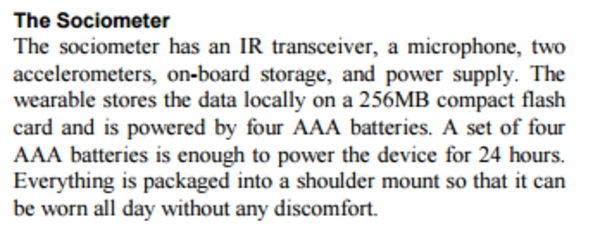
- Some specifications of the sociometer.
- 2 accelerometers.
- 256 MB on board storage.
- IR transceiver.
- Microphone.
- Power supply.
- Powered by 4 AAA batteries.
- Shoulder mount.

- Basically this device store information about these things.
- Information about nearby people.
- Motion information.
- Speech information.

- Other sensors can be added as well. For example like these.
- Light sensor.
- GPS.
- It is mentioned here that the researchers are not yet to use the data from motion sensors.
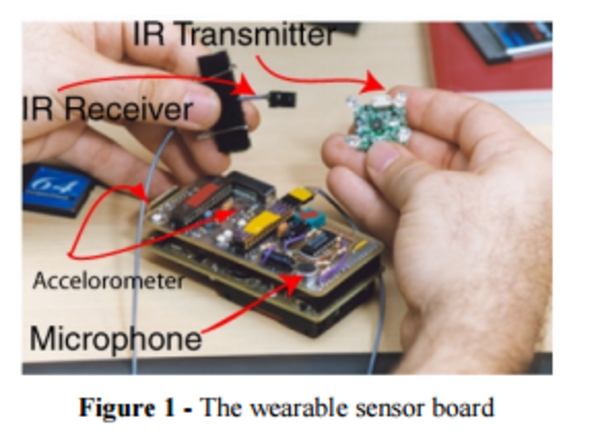
- Sociometer hardware.
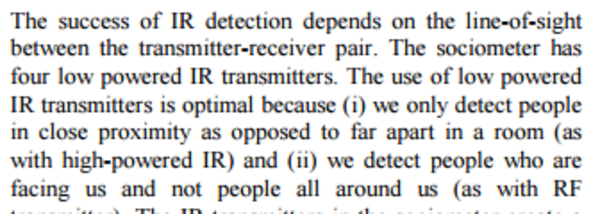
- The use of low powered IR transceiver is optimal because of these matters.
- Only detect people that is facing the sociometer wearer.
- Sociometer only detects people in close range.

- The transceiver create a cone shaped region in front of its wearer.

- IR range detection is approximately 6 feet.
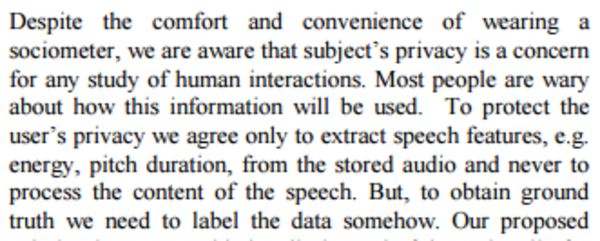
- Here are some concern about privacy.
- However, the researchers mentioned here that the data taken is only the important parameter without the context.
- For example for sound, the data extracted is only the features (pitch, volume, ...) without the contextual speech itself.

- It is called to garbling the audio.
- To make the audio features are all the same.
- But "encrypt" the voice.

- There was a problem with IR transceiver because the signals are not consistent.
- This is due to nature of human conversation that is not always face to face.

- There was also a problem that the IR transceiver detects face to face communication with its own wearer.
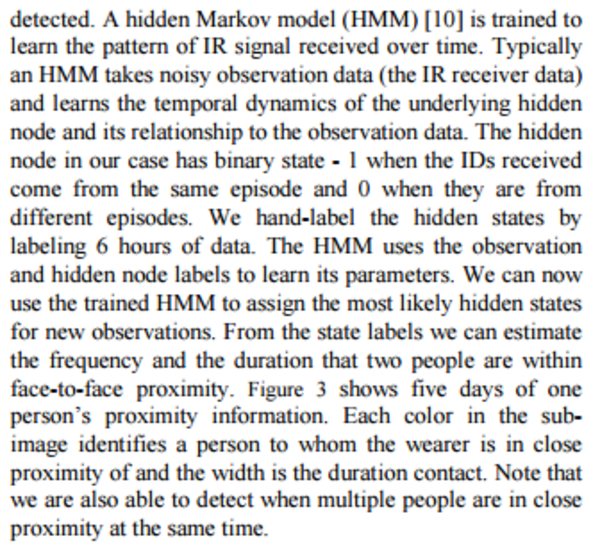
- Above is a quite specific explanation on how to calculate face to face detection.
- I do not read these things yet.
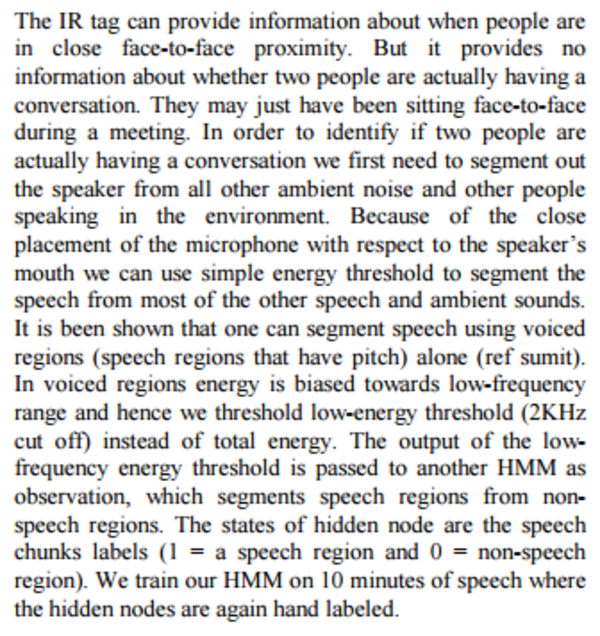
- Above is a quite specific explanation on how to combine face to face detector with the speech detector.
- These are all to detect if a conversation happen.
- Whether or not the sociometer wearer just blabbering around or having an actual conversation.
- I do not read these things fully yet, nor I understand these.
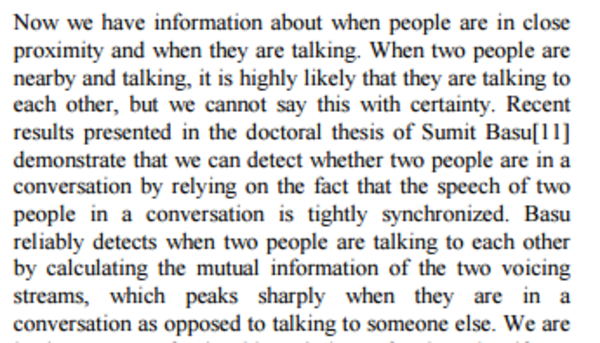
- Simple summation on the social noise.
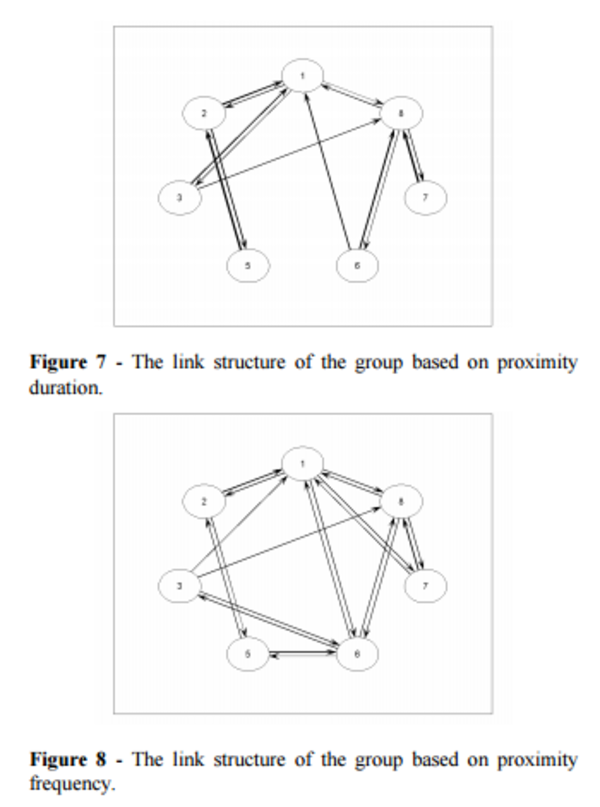
- Diagrams.
- I am not sure what are these for.
- But, these display on simplest sociometric flow. Please check into Moreno's Sociogram.